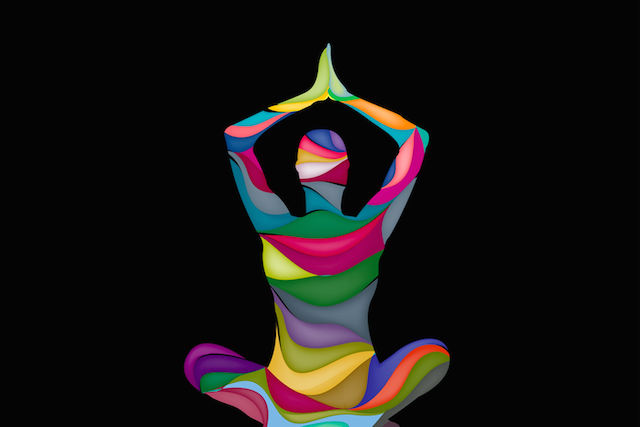
“The human mind is a relational and embodied process that regulates the flow of energy and information.” ~Daniel J. Siegel
We are emotional creatures, and we were born to express emotions freely and openly. Somewhere along the way, however, many of us learned to repress emotions, especially those deemed “negative,” in order to fit in, earn love, and be accepted. This was my experience.
I grew up in a home where the motto was “Children are to be seen, not heard.” There was little emotional expression allowed, let alone accepted. No one was there to validate or help us process emotions in a healthy way. Anger was met with anger, fear went unacknowledged, and there was plenty of shame to go around.
My parents didn’t model how to deal with difficult emotions, as they struggled with that themselves. When those emotions showed up, I often felt overwhelmed and inadequate, ashamed of my failure to be a “good girl.”
I learned to bury my pain deep inside, feeling invisible, ashamed, angry, alone, and unable to ask for what I needed. Trying to hide the pain—from others and myself—I built walls, put on masks, and soldiered on. For better or worse.
My pain was buried so deep, I didn’t realize it was there until I had my own children. Motherhood opened up old wounds, the house of cards fell apart, and I began to unravel.
In my thirties, faced with growing angst and creeping depression—and motivated to be the best parent I could be to my children—I began to deal with repressed memories and old emotional residue that has left me suffering from C-PTSD, chronic back pain, sciatica, headaches, and anxiety.
As a child, I hid from the emotional pain by delving into the world of books, music, and academics. As an adult, I realized I was strong enough to face it. I wasn’t a little child anymore; I didn’t have to hide. Now I was more mature and had the resources I needed to finally face the pain that used to overwhelm my young brain—and begin to heal it.
The truth is, we all hide our emotions occasionally. We pretend, avoid, and deny uncomfortable emotions in an effort of self-preservation, as a defense mechanism.
We do this most often with difficult emotions like shame, fear, or anger. When we experience events that emotionally overwhelm us and we’re unable to process what is happening, accept our emotions, and express them through our body and mind, we hide them deep inside us where others can’t see them. And we end up hiding them from ourselves too. Yet, they’re still there.
The unresolved emotions get trapped in our body, where they build and fester, draining our energy, leading to burnout, emotional imbalance, and eventually disease. When we chronically repress emotions, we create toxicity in our body, mind, and heart.
This unprocessed emotional energy is stored in our organs, muscles, and tissues. It leads to inflammation and chronic health problems, and it undermines our overall well-being.
3 Steps to Processing Emotional Energy Stuck in Your Body
The opposite of repression is expression. In order to process our emotional distress and move it through and out of our body so it doesn’t get stuck there, we need to learn to express our emotions in a healthy way, in the body and mind. But first, we need to learn to recognize and accept our feelings as they come and go.
Step 1: Recognize (self-awareness)
The challenge is to recognize the emotion and feel it in your body. This is where mindfulness comes in. The goal is to notice what is happening within our body, accept it, and feel it fully, without judgment.
If you’ve ever come across Tara Brach’s teachings on radical acceptance, the practice of R.A.I.N. should sound familiar. R.A.I.N. stands for recognize, allow, investigate, and nourish (with self-compassion), and it “directly de-conditions the habitual ways in which you resist your moment-to-moment experience,” according to Brach.
Buddhist teachings tell us that human suffering is caused by aversion and resistance to what is happening. Acceptance is liberating, and the practice of R.A.I.N. teaches us to accept our moment-to-moment experience instead of running from it. It teaches us to face any difficulty head-on, with self-compassion and the understanding that it will eventually pass.
We have to feel it to heal it—we have to fully experience the emotion in order to process and integrate it into our experience.
But we must feel it in the body; this is the critical point. As Brach writes, “If the process of including difficult emotions in awareness stops at the level of cognitive understanding without a fully embodied experience, the genuine acceptance, insight, and inner freedom that are the essence of true healing will not be complete.”
Practice mindfulness to get better at recognizing your feelings and observing the bodily sensations connected to those feelings as they come and go throughout the day. Offer yourself self-compassion as you go through more difficult emotions.
PRACTICE:
Sit still for a few minutes with your eyes closed. Listen to your body and become curious.
What does your body feel like right now? Is there any pressure or tingling? Where? Do you feel heavy, hot, contracted, warm, or cold? What is the texture, weight, and shape of the sensations you notice in your body? What emotions are those sensations connected to? Can you breathe into the parts that call your attention? What do those parts of your body want to tell you? What do they want?
Step 2: Respond (self-expression)
Emotions need to be expressed to be processed. The goal is to move the energy of emotion through and out the body so we can let it go.
This self-expression must be authentic and embodied. Remember, true healing occurs when body and mind integrate, so express the emotion on the bodily level first and foremost.
Still sitting, ask yourself: What does this emotion you just connected with need from you? What feels right in this moment? What do you need?
Maybe you feel the need to cry, scream into a pillow, go for a swim, walk or run, dance it out, hit a punching bag, do some gardening, tapping, yoga or TRE, paint your feelings out, or simply breathe deeply while facing the sun—whatever feels cathartic in that moment, do it.
You will free the poisonous emotion that you carried within yourself and free yourself from its shackles.
Follow this step with one of the best forms of emotional healing—journaling. Writing can be a very therapeutic experience of self-discovery, reconnecting with our true self, and processing our deepest feelings and emotions.
When we write, we give our internal world a voice. We process and make sense of what is happening within us and around us. And we gain perspective; by writing about our fears and hurts, we can look at them from a distance, detach from their grip, and eventually let them go. That release can be truly healing.
Practice journaling every day to get better at expressing and processing your feelings. Don’t censor or judge yourself; let it all out, completely unfiltered. Over time, your journal will become a safe space for you to free yourself, get unstuck, and move forward.
We often don’t have the time and space to process emotions in the moment, so make sure you allow yourself the space to feel the emotions you’ve had through the day and journal about it at the end of each day.
WRITING PROMPT
What is happening in your life right now that you wish you could change? What is the biggest source of frustration? As you write, notice the sensations in your body. Tune into the parts that are numb, in pain, or frozen. What are they trying to tell you? What needs healing, attention, or change?
Step 3: Reset (self-care)
If we’ve habitually neglected our bodies and ignored our emotions, we have to re-dedicate ourselves to body-mind self-care and indulge in healing habits that will bring in the feeling of well-being.
The goal is to realign back with your authentic self, reset back to a relaxed and open state, and come back into wellness and balance.
Take time to slow down and be alone, get out into nature, make art, listen to music while you cook your favorite dinner, meditate to cleanse your mind and relax your body, or take a bubble bath or a nap to restore. Take good care of yourself to awaken to life’s joy and simple pleasures that will nourish your body, mind, and soul.
My Own Healing Journey
When I decided to take charge of my own healing, I had no idea where to start. A lifelong bookworm, I quickly discovered writing to be therapeutic. It became my refuge, a place where I could connect with my inner world in an authentic way. Writing became my most trusted way of processing emotions I didn’t even know I harbored inside since childhood. I discovered shame, anger, fear, grief, and eventually, self-compassion.
With mindfulness, I learned to allow my pain to surface, if only for a brief time, then surround it with tender love and care. My pain was a part of me, and I was done running from it; it was time I faced it.
I learned to sense into my body, little by little, as the anxiety of reconnecting with my physical sensations was very powerful. But I realized the only way out was through—through the body—so in order to move the stuck emotions that had a tight grip over me for decades, I had to allow and accept them; I had to feel the anger, the shame, the grief.
Slowly, I learned to give my inner child the support she never received. I listened to and validated her pain—and helped her let go of it. I learned to love and accept her. And I finally learned to love and accept myself.
Healing is a taxing process. Remember to give yourself all the care and compassion you would give to a friend doing this hard work. Offer yourself understanding, love, and care. This is hard work, and you are doing the best you can with what you’ve got.
Trapped emotions get in our way. They sabotage our efforts to create the life we want and make us miserable along the way. Freeing this emotional energy stuck in our bodies can shift our lives in a positive way. It’s healing and liberating. And you are worth it!
About Joanna Ciolek
Joanna Ciolek is a self-taught artist, recovering self-critic, and the author of mindfulness-based prompt journals, The Art of Homecoming and The Art of Untangling. To learn mindfulness, reconnect with yourself, and begin your healing journey, join her Free Course at The Mindfulness Journal. Follow Joanna on Twitter, Instagram, and Facebook.
- Web |
- More Posts













 Though I run this site, it is not mine. It's ours. It's not about me. It's about us. Your stories and your wisdom are just as meaningful as mine.
Though I run this site, it is not mine. It's ours. It's not about me. It's about us. Your stories and your wisdom are just as meaningful as mine. 